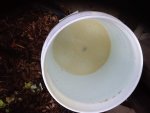Starlog for posterity re: swg cell performance in high phosphate water 
Continued flawless production of approx 1.5 ppm per day, approx 20%
FC 4.5
PH 7.4 (lowered 1x this week, but added jacks purple, which also lowered again)
TA 90
CH 90 (no purple flashpoint this time, but had added jacks)
CYA 70
Iron .2 or lower, hard to tell, slightly above shade of zero. Lowest its been.
Effects of jacks purple...mild iron stains on steps cleared immed. with one bottle (half startup dose). Will not add more til/if stains return.
Will test po4 next week for delta...also bought alum for future jar test out of curiosity and possible future treatment.
Continued flawless production of approx 1.5 ppm per day, approx 20%
FC 4.5
PH 7.4 (lowered 1x this week, but added jacks purple, which also lowered again)
TA 90
CH 90 (no purple flashpoint this time, but had added jacks)
CYA 70
Iron .2 or lower, hard to tell, slightly above shade of zero. Lowest its been.
Effects of jacks purple...mild iron stains on steps cleared immed. with one bottle (half startup dose). Will not add more til/if stains return.
Will test po4 next week for delta...also bought alum for future jar test out of curiosity and possible future treatment.


